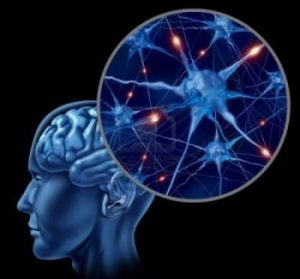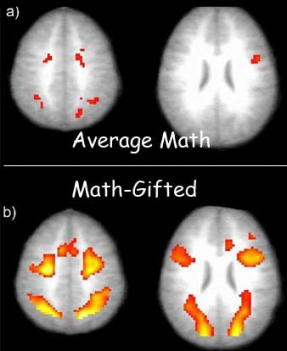 by Sharon Duncan, Corin Goodwin, Joanna Haase, PhD, MFT, and Sarah Wilson
by Sharon Duncan, Corin Goodwin, Joanna Haase, PhD, MFT, and Sarah Wilson
A collaboration of GHF: Gifted Homeschoolers Forum and GRO: Gifted Research and Outreach
It’s often observed that gifted children benefit from a more accelerated pace of learning than most other children. While science supports this observation, it does so with some caveats. Studies show that gifted individuals have increased bilateral brain activation,1 and brain activation is more pronounced when gifted individuals are provided challenge.2,3 When combined with greater regional brain volumes,4 and increased white matter tracts,5 this increase in activation may provide insight into commonly observed gifted behaviors.
Parents and some educators often conjecture that in order for a gifted child to be “well behaved/engaged” we must limit the repetition, because otherwise the child will lose interest and therefore engagement in the learning process. This lack of interest and disengagement lead to boredom beyond the standard “but I don’t wannaaaaaa!” Like all other children, gifted children deserve the opportunity to learn something new and be continually academically challenged.
In fact, we often see that gifted children seem to thrive on challenge. This need for increased engagement could be why some gifted and twice-exceptional children are particularly difficult to pinpoint in assessments. The testing tools that begin with simpler questions and then build in complexity may be too basic for these kids, who then get antsy and make up or play around with their answers, get distracted, make actual mistakes, and end up getting cut off before reaching the “interesting” material.
In classrooms, this need for increased brain activation can manifest as fidgeting or inattention. The bored brain will naturally seek engagement elsewhere, often leading the child into trouble that spirals downwards in behavior and into self-doubt. For example, a child may feel anxious when they get an answer right the first time, yet everyone else needs repetition. They begin to question themselves and perhaps overcomplicate and overthink questions and assignments. When students finish an in-class assignment early, the teacher may tell them to review their work, thereby amplifying the cycle of self-questioning and self-doubt. Children only know their own experience, so they may assume that they are messing up or missing something by completing their work so quickly.
That said, understanding new material and understanding expectations in order to apply or implement it at a higher level are separate issues. For example, a young gifted child may have a firm grasp on the general concepts of astrophysics, but that is not the same as having all of the skills needed to perform college- or professional-level work in that field. A child who understands a given concept does not necessarily have the skills and/or ability to demonstrate that knowledge in every circumstance.
Though the degree may vary among children, gifted kids need to learn how to differentiate between needing a few repetitions to learn a concept and practicing in order to build up speed and efficiency. The lack of understanding on their part can increase their frustration and undermine any motivation they may have. Learning this difference, however, be done in a meaningful way. For instance, contextual learning has the added benefit of heightening interest through applied involvement. Rather than sitting a child down in front of worksheets to practice multiplication tables, allow them the opportunity to design a Lego structure to reinforce the concepts, such as how many 2×6 bricks in blue and how many 2x8s in red does the specified structure need?
Gifted educators and parents often toss around the term “whole-to-part learning,” which describes the child who can understand large concepts, but does not have the underpinning concepts in place. Either they cannot get there on their own or understand how apply them, or they simply do not see the point in the individual steps without knowing where they are leading. These kids need to work backwards in learning, which runs counter to the sequential approach traditionally used in traditional curricula. Understanding the goal gives purpose to learning even when the immediate bit of knowledge doesn’t provide significant brain activation. The introduction to the Big Picture, so to speak, excites the child, and they become motivated to fill in the foundational knowledge and learn to apply it. For example, a child who absolutely refuses to learn another language but has an obsession with Pokémon might be willing to learn the basics of Japanese or their native language by translating Pokémon names into yet another language, and breaking it down from there. Similarly, some children learn to read using phonics, but others benefit from recognizing words such as “titanic” and then applying similar sounds to “cat.” Sounding out letters might be boring, but recognizing a word that relates to their interest can be exciting!
Kids need help finding ways to learn based on their strengths. The greater their asynchronies, the more critical this is. Young gifted learners should be permitted to go at the pace their brains demand, supported by explanations for why it matters and using material that engages them.

Research has shown that the brains of mathematically-inclined gifted children* are quantitatively and qualitatively different from those of average math ability. Their brains exhibit greater overall cortical activation, and extensive bilateral activation compared to average math ability children when performing tasks of mental rotation.6 In essence, their brains are engaged and in flow, working at a high capacity as a coordinated unit. We can conjecture that an energized, excited brain will not only operate more efficiently and effectively, it may also overflow into physical movement as well. The gifted child may pace, fidget, or otherwise appear inattentive, when in fact their bodies are mirroring their neurological activity. In brain scans, a gifted child’s brain appears to be on fire.7
If the brain doesn’t have someplace good to go, it is more likely to go someplace bad. ~Joanna Haase, PhD, MFT
Learning to be a good steward of your brain is as important as taking care of your physical body. Neglecting the brain can cause a stress response leading to increasing agitation. It should be no surprise that areas of super-stimulability, including imaginational and emotional, when left unchecked, can lead to depression and existential depression, which is a basically whole-to-part depression found predominantly in the gifted population.8 The gifted brain thinks about a big overwhelming concept, but has trouble breaking it down to manageable parts. As a result, a young gifted child may see homeless people on the street and feel exceptionally distraught by the many aspects of this social issue. The child is as yet unable to tease apart the various factors that contribute to homelessness, which requires a caring adult to provide guidance and suggestions, such as volunteering in a soup kitchen or collecting warm clothes for donation.
Early on, children should learn to recognize the feeling of flow and use that to enter into a state of productivity that works for them. Additionally, they need to learn how to manage the emotional elements of flow and intellectual excitement. As discussed earlier in this series, children may not yet have the brain maturity, but that does not mean they will never have it. Though their brain is still maturing, they should learn how to manage these big feelings without being shamed or made to feel afraid of having them. As influencing adults, we need to embrace this increased activation and the intensity it brings, giving children the opportunity to experience it early and often.
The greater activation of the gifted brain has quite an assortment of implications for parenting and educating a gifted child. Connectivity is also an issue; just imagine all of those different brain regions working together while moving at different rates!
Next we’ll look at greater sensory sensitivity in the gifted brain. (Find it here)
——–
*We don’t call them “mathematically gifted” because calling someone gifted in a specific subject area feeds into the idea that giftedness is what they do, not who they are. Area-based strengths are the manifestation of their brains moving into flow when they are activated and engaged.
- Manuel Desco, Francisco J. Navas-Sanchez, Javier Sanchez-González, Santiago Reig, Olalla Robles, Carolina Franco, Juan A. Guzmán-De-Villoria, Pedro García-Barreno, and Celso Arango, “Mathematically Gifted Adolescents Use More Extensive and More Bilateral Areas of the Fronto-Parietal Network than Controls During Executive Functioning and Fluid Reasoning Tasks,” Neuroimage57(1), July 1, 2011, accessed June 25, 2018: 281-292. https://doi.org/10.1016/j.neuroimage.2011.03.063.
- Desco, “Mathematically Gifted Adolescents Use More Extensive and More Bilateral Areas of the Fronto-Parietal Network than Controls During Executive Functioning and Fluid Reasoning Tasks,” 281-292.
- Kun Ho Lee, Yu Yong Choi, Jeremy R. Gray, Sun Hee Cho, Jeong-Ho Chae, Seungheun Lee, and Kyungjin Kim, “Neural Correlates of Superior Intelligence: Stronger Recruitment of Posterior Parietal Cortex,” Neuroimage 29(2) January 15, 2006, accessed June 25, 2018: 578-86. https://doi.org/10.1016/j.neuroimage.2005.07.036.
- Richard J. Haier, Rex E. Jung, Ronald A. Yeo, Kevin Head, and Michael T. Alkire, “Structural Brain Variation and General Intelligence,” Neuroimage 23(1) September 2004, accessed June 25, 2018: 425-33. https://doi.org/10.1016/j.neuroimage.2004.04.025.
- Francisco J. Navas‐Sánchez, Yasser Alemán‐Gómez, Javier Sánchez‐Gonzalez, Juan A. Guzmán‐De‐Villoria, Carolina Franco, Olalla Robles, Celso Arango, and Manuel Desco, “White Matter Microstructure Correlates of Mathematical Giftedness and Intelligence Quotient,” Human Brain Mapping 35, issue 6 (2014) accessed June 24, 2018: 2619-31. https://doi.org/10.1002/hbm.22355.
- Michael W.O’Boyle, RossCunnington, Timothy J.Silk, DavidVaughan, AriSyngeniotis, Gary F.Egan, “Mathematically Gifted Male Adolescents Activate a Unique Brain Network During Mental Rotation,” Cognitive Brain Research 25(2) October 2005, accessed June 25, 2018: 583-7. https://doi.org/10.1016/j.cogbrainres.2005.08.004.
- Brock Eide and Fernette Eide, “Brains on Fire: The Multinodality of Gifted Thinkers,” New Horizons for Learning, December 2004. http://archive.education.jhu.edu/PD/newhorizons/Neurosciences/articles/Brains%20on%20Fire/index.html.
- James T. Webb, PhD, “Dabrowski’s Theory and Existential Depression in Gifted Children and Adults,” Davidson Institute, accessed June 25, 2018, https://www.davidsongifted.org/Search-Database/entry/A10554.